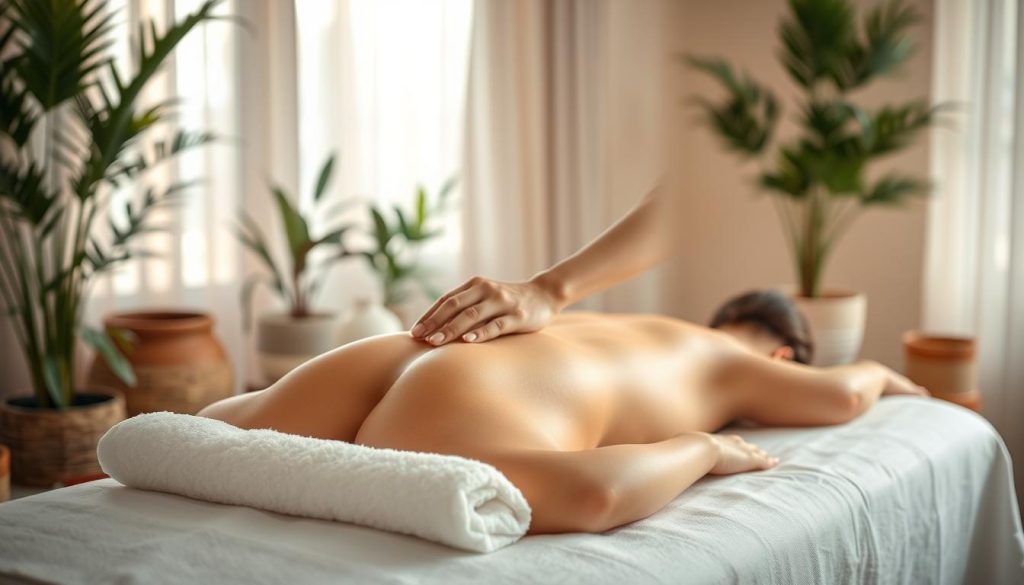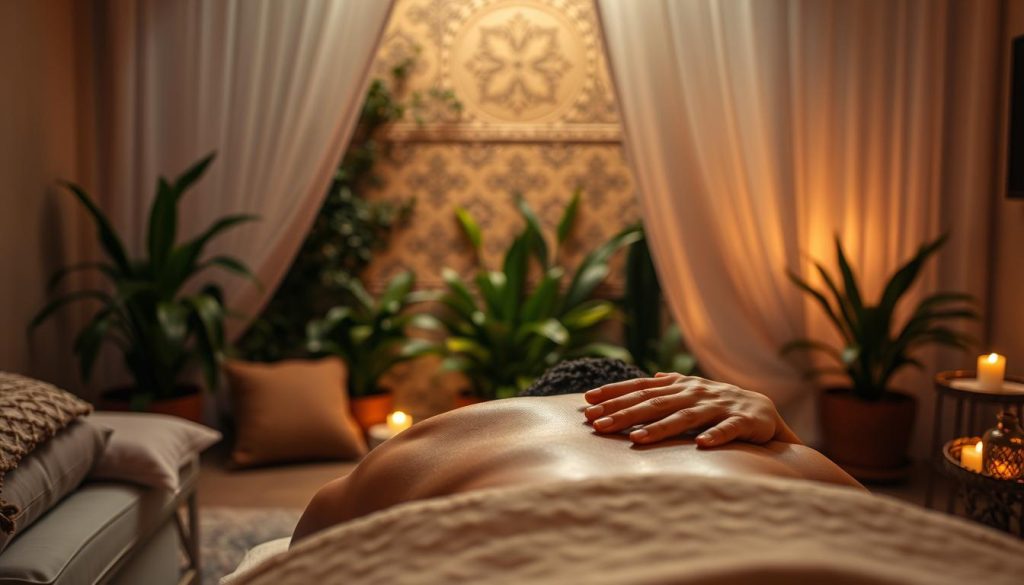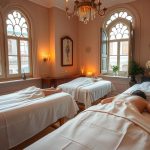Have you ever wondered whether a single session can calm your mind and reset your body during a busy trip? This guide cuts through the options so you can pick a treatment that fits your schedule and goals.
In Istanbul, spas offer a range of approaches, from gentle Swedish massage strokes to targeted reflexology and hot stone therapy. Each method aims to lower cortisol, ease tight shoulders and jaw, and help you sleep better that night.
Top providers like Victory Spa and traditional hamams pair trained therapists, private rooms, and custom oil blends to boost results. You’ll learn the main types, the realistic benefits, and what to ask before you book.
Key Takeaways
- You can feel calmer and clearer the same day with the right session.
- Swedish basics, aromatherapy, and targeted work serve different needs.
- Professional settings, oils, and trained staff matter for outcome.
- Short treatments can still reduce tension and improve sleep.
- Check session length, focus areas, and post-treatment tips before booking via anti-stress programs.
Why you seek stress relief in Istanbul right now
When life speeds up, your body often sends clear signals: stiffness, headaches, and fatigue. You notice it first around the shoulders, neck, and jaw after long commutes or desk hours.
How modern urban life triggers muscle tension and anxiety
How modern urban life triggers muscle tension and anxiety
You live on tight schedules and sit for long stretches. Those repetitive postures limit natural flow in soft tissues and let small aches grow into lasting pain.
Mental overload also maps onto your muscles. That loop—stress increasing tension, and tension fueling more stress—quickly wears you down as a person.
The immediate benefits you can feel after a single session
Hands-on work often brings fast relief. After one session you may breathe easier, notice fewer headaches, and sleep more soundly the same night.
Local spas and Victory Spa report quick drops in cortisol and faster recovery with non-invasive touch versus some alternatives. You can also regain focus and reclaim time when the fog lifts.
- You move with less stiffness and feel more comfortable during daily tasks.
- Therapists pace pressure to steady your nervous system without overwhelm.
- You can pick from several types, including a classic swedish massage, to match your needs.
For guidance on practical programs and booking, consider this helpful resource for long-term wellness: why choose massage in Istanbul.
What Are Stress-Reducing Massage Techniques in Istanbul?
Each treatment brings a different mix of strokes, pressure, and scent so you can pick what soothes your muscles and mind.

Swedish massage blends long stroking, kneading, friction, and light vibration to ease full-body tension. It’s ideal when you want smooth, flowing contact that helps tissues relax and circulation improve.
aromatherapy options and calming blends
Aromatherapy massage uses essential oils like lavender, chamomile, and sandalwood to calm the nervous system. The scent supports sleep and amplifies gentle pressure for a soothing session.
stone-assisted release and warmth
Hot stone therapy places warm stones over tight areas so tissue loosens without heavy force. Heat helps deeper layers release while you remain comfortable.
reflexology and focused foot work
Reflexology applies targeted pressure to foot zones linked to other systems. It’s a non-invasive choice when you prefer feet-focused care that aims for whole-body balance.
deep, targeted approaches
Deep tissue massage uses slow, strong strokes to break adhesions and relieve chronic pain. Therapists focus on bands of tissue to improve blood flow and reduce stubborn knots.
gentle anti-stress sequences
Anti-stress massage emphasizes rhythmic kneading, tapping, and light vibration to lower cortisol and calm overworked areas. It’s a good pick when relaxation is the main goal.
stretching and acupressure styles
Thai and Shiatsu sessions mix assisted stretches with acupressure to restore energy flow and mobility. They feel more active and can improve flexibility.
soothing bali-style strokes
Bali massage features soft, nurturing strokes that boost circulation and leave limbs feeling lighter. You can combine methods across visits to handle both immediate relief and longer-term balance.
For therapist tips and practical follow-up steps, see relaxation advice from local therapists.
How these massage techniques reduce stress in your body and mind
A short session can change how your nervous system reacts—fast. Gentle, rhythmic contact uses measured pressure and sequenced strokes to signal your nerves to shift from high alert to a calmer state. This is why many treatments produce near-immediate relief.
From pressure and strokes to nervous system regulation
Consistent pressure and steady flow retrain your body to down-regulate. Slow, predictable inputs tell your nervous system that threat levels are low, so muscles and tissues stop guarding.
You can ask the therapist to adjust pressure minute by minute so your tissues soften without triggering more pain.
Endorphins, serotonin, and the pathway to better mood and sleep
Hands-on work often boosts endorphins and serotonin, which lift mood and help sleep improve the same night. Lowered cortisol follows gentle, rhythmic work, supporting deeper rest and clearer focus.
- You feel warmer limbs and easier mobility as improved circulation brings oxygen to stiff areas.
- Mental clarity improves because paced breathing and steady touch reduce sensory overload.
- This non-invasive therapy suits daily wellness routines and gives practical treatment with no downtime.
For tips on follow-up care and local options that promote relaxation, see a helpful hamam guide or a therapist resource for practical booking and aftercare.
Turkish hamam relief · local therapist guidance
Hands-on methods therapists use to relieve tension
A skilled therapist uses layered touches to coax tight muscles into relaxing and moving freely. These sessions combine grips, rhythmic passes, and targeted taps so your body feels lighter and rest comes easier.

Kneading, rubbing, and stroking: melting muscle stiffness
Kneading lifts and rolls tissue to warm soft structures and ease stiffness. This helps tight bands soften as tissue separates from underlying layers.
Rubbing focuses on the neck, jaw, and temples to ease desk-related headaches and restore facial flexibility.
Stroking uses long, steady passes to support circulation and soothe superficial tissues for broader calm.
Vibration and tapping: stimulating lymph flow and easing fatigue
Vibration applies quick fingertip motion to support lymph flow and clear built-up fatigue. Tapping targets hotspots with measured contact so your tissues accept change.
Deep tissue methods use slow, deliberate force to release adhesions in small zones while lighter work keeps your whole system relaxed.
| Method | Primary effect | When to request |
|---|---|---|
| Kneading | Warms and separates tissue; reduces stiffness | Stiff shoulders, morning tightness |
| Rubbing & Stroking | Relieves headaches; restores superficial circulation | Desk strain, facial tension |
| Vibration & Tapping | Boosts lymph flow; targets hotspots | Fatigue, localized knots |
| Deep tissue | Releases adhesions; improves function | Chronic bands, persistent pain |
Practical tips: Ask the therapist to modulate pressure, combine deep work with gentle warm-up, and sequence techniques so changes integrate smoothly. You can build lasting mobility by combining sessions and by using aromatherapy options like those offered by aromatherapy options. For guidance on choosing and to trust trained therapists, consult local resources before booking.
Essential oils that promote relaxation and relieve anxiety
Scent matters as much as touch. Therapists often select essential oils to support calm breathing, ease the mind, and help your nervous system settle during a session.
Lavender, chamomile, rose, sandalwood: when to choose each scent
- Lavender: Use for classic calming that eases racing thoughts and helps you breathe deeply.
- Chamomile: Pick this when you feel overstimulated; it soothes persistent jitters.
- Rose: Request rose to reduce anxiety and gently relax the nervous system.
- Sandalwood: Choose sandalwood for a grounded, tranquil aroma that encourages stillness.
Carrier oils and skin benefits
Sweet almond, jojoba, and grapeseed are common bases that make scents safe and glide-friendly on your skin.
- Sweet almond hydrates and suits dry or sensitive skin.
- Jojoba feels non-greasy, offers anti-inflammatory support, and can help lower cortisol effects on the skin.
- Grapeseed is light, antioxidant-rich, and softens without heaviness.
- When the right base pairs with essential oils, smooth strokes can also aid healthy blood flow and circulation.
Tip: Ask for a custom blend that matches your goals so scent, sound, and touch work together to promote relaxation and a true body soul reset. For booking ideas or tailored options, see this short local guide on aromatherapy massage and related services.
Choosing the right massage and therapist in Istanbul for your needs
Choosing the right therapist and treatment makes a short visit feel like true recovery.
If you are a busy professional, traveler, student, or someone with insomnia, pick a session that matches your routine and symptoms.
If you’re a busy professional, traveler, student, or dealing with insomnia
You can book a focused type massage for lunch-break ease or a longer treatment when you have more time.
Targeted work on neck, shoulders, and lower back helps reduce muscle pain from travel or late nights and gives fast relief.
Contraindications: when to wait or seek medical approval
Ask before you book if you’ve had recent surgery, acute inflammation, severe skin issues, or pregnancy.
Spas will require medical approval for infections or open wounds so your session is safe and effective.
What to look for in a spa: trained therapists, private rooms, customizable oils
- Confirm therapists have hands-on training in anti-stress approaches and can modulate pressure.
- Look for private rooms, calm lounges, and customizable aromatherapy blends to support your outcome.
- Plan follow-up treatments as a practical strategy to maintain gains without overloading your schedule.
“Choose a therapist who listens to your cues and tailors pressure and sequence to your comfort.”
For guidance on verified practitioners, see this local resource for professional therapists: professional therapists guide.
Conclusion
Your next session can be the reset you need, blending quick relief with longer-term gains for muscles and mood.
From Swedish and aromatherapy to hot stone, deep tissue, Thai and Shiatsu massage, and gentle Bali or reflexology options, Istanbul offers styles that target tension with trained hands and custom oils.
You can expect real benefits: less pain, improved blood flow, easier movement, and steadier sleep. Ask therapists to match pressure and mix methods so deep tissue sequences relieve muscle pain without overstimulation.
Build a routine—weekly or monthly sessions help your body learn to relax. For practical guides and local choices, see this overview of popular approaches and booking tips at popular massages guide and a curated local selection for women at women’s therapy choices.
Leave each visit feeling reset: tension eased, pain reduced, and the body ready for daily life with calmer flow and restored relaxation.






